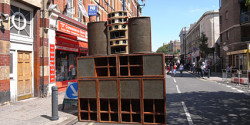I’ve been thinking a lot about reports that the United Kingdom’s broadcast regulator has shut down 400 pirate radio stations over the last two years, many of them situated in London. Well over a third of those Ofcom busts took place in two boroughs: Haringey in North London and Lambeth in South London. Why these specific areas? Radio Survivor reader Jerry Drawhorn asks some good questions in a response to my post:
“I’m wondering if these are ethnic neighborhoods where the broadcasters might be filling a gap in the regulated BBC and community radio programming? Are they predominantly music programmers? Religious? Foreign language? Kids with a knack for electronics? Why the desire for broadcast rather than an internet station?”
I pondered some of these queries in my contribution to our sixth podcast. To get at the situation I tapped into the London Poverty Profile, which has tons of data about that city’s nearly three dozen boroughs. Here’s what the profile says about Haringey:
• “Haringey is the most unequal borough in London, with over half of its wards being either very rich or very poor.”
• “[N]ow one of the more dense London suburbs,” although density tends to predominate on Haringey’s east side.
• The borough is “notable for its ethnic diversity,” with many residents of Caribbean, African, Pakistani, Chinese, Turkish, and Cypriot backgrounds.
Next comes Lambeth:
• “With about 112 persons per hectare, it also is one of the most densely populated boroughs in London, and with population growth exceeding projections; Lambeth could be the most populated Inner London borough by 2020.”
• Lambeth is noted for its ethnic diversity “with a particularly high proportion of and Black-Africans (12%) and Black Caribbeans (9.5%) While the borough has an extremely young profile, Lambeth is notable for its ethnically complex older population too, substantiating the historical narrative that Lambeth was an important focus and destination for post-World War Two immigrants from the Caribbean and from Africa.”
London, by the way, is already the most unequal part of the United Kingdom, according to the index. 16 percent of its residents are the poorest in the UK; 17 percent are the richest. Lambeth and Haringey have among the highest teenage pregnancy rates in the city, indicating the youthfulness of their respective populations. Lambeth’s Brixton district won notoriety in the early 1980s when many of its African-Caribbean residents took to the streets against police repression and high unemployment.
Here we have two dense, unequal, and very young urban areas. It sounds like these people have a lot to talk about. A comment from RK Henderson of the Net Radio Blog notes that radio pirates from these boroughs bear little resemblance to the Radio Caroline broadcasters of The Sixties:
“Today’s pirates are small, terrestrial, urban, and furtive. They broadcast mostly to the immediate neighbourhood from high buildings, generally from a hidden, shoebox-sized transmitter that is keyed remotely and feeds a camouflaged antenna on the roof. (Alternatively, some operate from vans.) These are low-power, intermittent operations that target a small listenership; basically what Americans call LPFM, except unlicensed.”
Indeed, there are apparently so many of them that they may be driving some listeners away from the FM band, noted radio futurologist James Cridland in a response:
“I have a suspicion that the pirate radio stations here are partially why radio listeners – in London at least – are now mostly using digital at home – DAB, internet, DTV – which is where we listen to radio most in the UK. I find my FM listening being badly interrupted by pirate radio on the way to the supermarket in the car. (I live in Enfield, just north of Haringay).”
Ofcom, the UK’s broadcast regulator, has an advisory page against pirate radio that urges its adherents to embrace community radio instead. But are any of London’s ten community radio stations specific to these two boroughs? I’m not sure. Here’s the list from this map:
Desi R– Southall
Hayes FM – Hayes
Bang – Stonebridge & Harlesden
NuSound R – Newham
Resonance FM – C London
Voice of Africa – Newham
Westside CR – Southall
Rinse FM – Inner London
Reprezent – S London
Insanity – Egham
Betar Bangla – Tower Hamlets
In any event, perhaps the most interesting comment we got from our initial post was a reaction to an Ofcom official telling The London Evening Standard that London’s pirate radio problem is unique. “From the enquiries we’ve carried out, this problem doesn’t exist in New York or Rome or Paris,” Clive Corrie told the Standard, “it’s a London phenomenon.”
“I don’t know what inquiries Mr. Corrie carried out, but he was not very well informed by his sources,” responded Brooklyn Pirate Watch:
“Interference caused by pirate radio is a HUGE problem in certain parts of New York City — but not in ritzy Manhattan or northern Brooklyn, so it doesn’t get much attention. There are up to 36 pirates at any given time choking the FM dial and crowding out legitimate broadcasters in central and southern Brooklyn, particularly in areas around Flatbush, the pirate nexus of Brooklyn. There are also many pirates in the Bronx and, to a lesser degree, Queens.”
There is a book titled London’s Pirate Radio Pioneers that appears to go as far as 1989. But that, of course, was a quarter of a century ago. I think it is time for an update.



